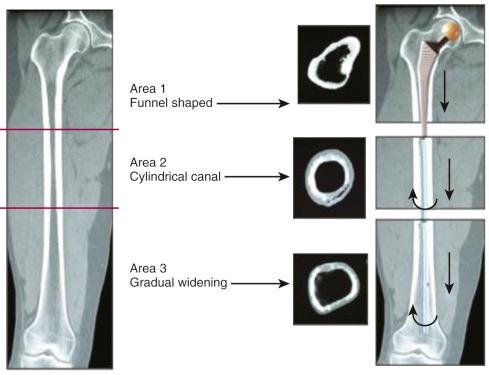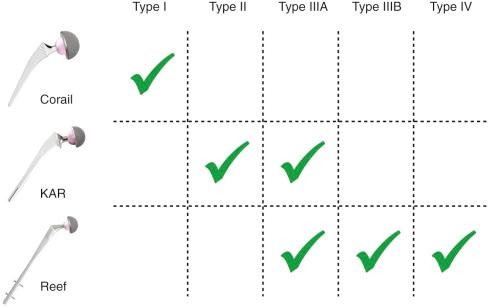Physical Address
304 North Cardinal St.
Dorchester Center, MA 02124
Planning: Careful preoperative templating
Instruments: Specific and complete instrumentation
Implants: System of fully hydroxyapatite-coated stems
Fixation: As proximal as possible
Anchoring: As distal as necessary
The choice of cementless versus cemented implants for mild and moderate bone stock loss is still a topic of controversy. Cementless femoral revision surgery for cases of severe deficiency has increasingly gained acceptance over the past decade because it can provide firm distal fixation and thereby overcome defects of damaged proximal bone.
Revision following major femoral component loosening can be difficult both in terms of finding a means of stable fixation of the revision implant and finding viable bone stock. Adequate primary stability must be attained to allow restoration of badly damaged bone around the new implant and to ensure the sound and lasting osteointegration of the new device. Stability will be dependent on the preoperative condition of the femur (e.g., granuloma, osteolysis, fracture, implant breakage) and on what happens at the revision surgery (e.g., inadvertent perforation, fracture, cortical window, extensive femoral osteotomy). Hydroxyapatite (HA) is a naturally occurring mineral form of calcium with the chemical composition Ca 5 (PO 4 ) 3 (OH). The crystal form of the material is composed of 2 crystals, thus yielding the composition Ca 10 (PO 8 ) 6 (OH) 2 . Its osteoconductive properties have made it an attractive material for coating both primary and revision total hip arthroplasty (THA) components. This has led to successful fixation of HA-coated implants in the presence of well-vascularized native bone.
All of these considerations mean that specially designed devices will be required to attain the necessary primary stability and to find a solution to the individual patient's needs. A whole system ( Fig. 101.1 ) adapted to the different situations encountered in revision surgery is required. Nevertheless, on the femoral side, to accomplish the objective of stable implant fixation, we follow a step-by-step strategy that, with appropriate planning and adequate instrumentation and implants, can be summarized as “replacing the initial stem by another with fixation as proximal as possible and as distal as necessary.” Although numerous techniques have been described to successfully achieve adequate fixation of the femoral stem in revision THA (these techniques are covered elsewhere in this book), our preferred techniques use HA-coated implants. The purpose of this chapter is to discuss the use of such implants in revision of the femoral component in revision THA.

Implant stability is mandatory at the time of surgery: Successful femoral reconstruction with an uncemented stem requires immediate axial and rotational stability, and the implant must have intimate contact with the living host bone to promote osteointegration needed for definitive fixation. Stabilization depends on different bony lesions but also on the shape of the distal femoral canal, where the bone of best quality is located. Three areas can be considered: area 1, the proximal part, with its funnel-shaped cavity; area 2, the medial part, with a canal that is more or less cylindrical; and area 3, the distal part, characterized by gradual widening ( Fig. 101.2 ).

In area 1, a quadrangular implant with a double-tapered geometry will easily find its primary stability and will efficiently resist axial and rotational stresses. In Paprosky type I and IIA femurs, a stem designed for primary insertion provides reliable initial fixation. In such situations, our preferred implant is the Corail stem (DePuy, Warsaw, IN), a grit-blasted straight device of quadrangular cross-section entirely plasma sprayed with a 150-µm layer of pure HA (see Fig. 101.1A ). This stem has proved its value in primary hip arthroplasty.
In area 2, even a strong diaphyseal fit provides only poor protection against the different forces. In patients with substantial bone loss (Paprosky types II and IIIA), a longer revision stem, the KAR (DePuy, Warsaw, IN), increases the bioactive area in contact with fresh bone, facilitating osteointegration (see Fig. 101.1B ). The KAR has the same proximally flared pattern as the Corail, but the stem is 25% longer to bridge bone defects or occasional windows. Two distal slots in the sagittal and coronal planes reduce global rigidity and prevent stress risers in the cortex at the tip of the stem.
In area 3, there is no possibility of finding effective mechanical stability through close contact between implant and bone. Interlocking screws must be used to increase axial and torsional stability. The REEF (DePuy, Warsaw, IN) is our dedicated implant for very severe deficiencies (Paprosky types IIIB and IV) when very distal fixation is needed ( Video 101.1 ; see also Fig. 101.1C ). The REEF is a modular device that is basically composed of 2 main elements. The first and more distal segment is a metaphyseal-diaphyseal element, conical in its proximal part and cylindrical in its diaphyseal part. The proximal zone is 100 mm high, with horizontal macrostructures to increase the surface of contact and to prevent subsidence. The distal zone, of variable length, has a slight bow to prevent anterior cortical contact, longitudinal grooves to enhance osteointegration, and several horizontal holes for locking with 5-mm-diameter screws. The second and more proximal segment is a metaphyseal component fitted onto the stem with a Morse taper. This neck unit allows the surgeon to fine-tune anteversion within the confines of the existing metaphyseal bone and to restore leg lengths. In addition, this segment has an optional trochanteric claw that can be fixed to stabilize the greater trochanter and to improve the lever arm of the gluteal muscles if required.
Revision total hip arthroplasty using the REEF femoral component.
Though aseptic loosening is the most common reason for revision THA, the indications for revision using HA-coated stems include several other diagnoses as: pertrochanteric fracture with cerclage of the greater trochanter, periprosthetic fracture, tumor resection, extensive osteolysis, and reimplantation in 1- or 2-stage exchange arthroplasty for the treatment of chronic infection at the site of total hip arthroplasty. The choice of revision stem depends primarily on the extent of bone loss ( Fig. 101.3 ). Revision of implants for pain and severe stress shielding has also been discussed by some authors.

Preoperative planning is essential to determine the appropriate size and alignment of the new implant and the length of the femoral neck component. For thorough preoperative planning, the surgeon will need a full set of revision implant templates and the following radiographs: an anteroposterior (AP) film of the entire pelvis and AP and lateral films of the affected femur. Considering the affected femur with its failed implant, successive templates are laid on the AP radiograph of the joint until optimal filling of the medullary canal is achieved and the new stem extends distally beyond damaged femoral bone and at least 2 cortical diameters distal to any osteotomy that is required to remove existing implants. This step determines the type and size of implant to be used. Although this is less reliable than in the primary situation, preoperative planning also enables the surgeon to identify any weak zones that will need to be bridged and to assess the quality of diaphyseal filling. Where necessary, the appropriate degree of calcar bone grafting should be established. The level of insertion of the new implant, with the greater or lesser trochanter as reference, and calcar height can be determined to ensure equal leg length. If a modular stem seems to be the appropriate implant, templating should assess the combination of components needed to achieve stability of the implant and to restore leg lengths. The location of eventual interlocking screws is also determined, keeping in mind that a minimum distance of 3 cm is needed between the distal extent of damaged bone and the first locking screw.
The surgical approach selected is mainly dependent on the surgeon's preference and experience, keeping in mind that in the great majority of challenging situations, extraction of the failed prosthesis and reconstruction of extensive bone defects are often easier using a posterior approach, which is more extensile and more easily amenable than other approaches to the addition of femoral osteotomies.
The acetabular surgery is usually carried out first, with replacement of the acetabular insert alone or of the entire cup system (the trial implants may be left in position or the final cup may be installed).
The femoral stage of surgery consists of several steps, as described in the next section.
Become a Clinical Tree membership for Full access and enjoy Unlimited articles
If you are a member. Log in here